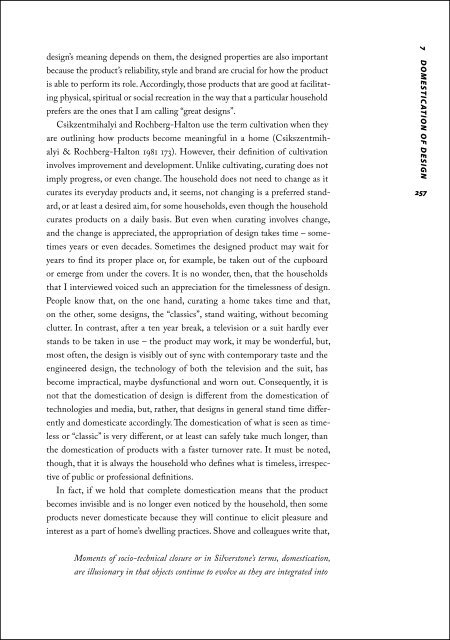Lataa ilmaiseksi
Lataa ilmaiseksi
Lataa ilmaiseksi
You also want an ePaper? Increase the reach of your titles
YUMPU automatically turns print PDFs into web optimized ePapers that Google loves.
design’s meaning depends on them, the designed properties are also important<br />
because the product’s reliability, style and brand are crucial for how the product<br />
is able to perform its role. Accordingly, those products that are good at facilitating<br />
physical, spiritual or social recreation in the way that a particular household<br />
prefers are the ones that I am calling “great designs”.<br />
Csikzentmihalyi and Rochberg-Halton use the term cultivation when they<br />
are outlining how products become meaningful in a home (Csikszentmihalyi<br />
& Rochberg-Halton 1981 173). However, their definition of cultivation<br />
involves improvement and development. Unlike cultivating, curating does not<br />
imply progress, or even change. The household does not need to change as it<br />
curates its everyday products and, it seems, not changing is a preferred standard,<br />
or at least a desired aim, for some households, even though the household<br />
curates products on a daily basis. But even when curating involves change,<br />
and the change is appreciated, the appropriation of design takes time – sometimes<br />
years or even decades. Sometimes the designed product may wait for<br />
years to find its proper place or, for example, be taken out of the cupboard<br />
or emerge from under the covers. It is no wonder, then, that the households<br />
that I interviewed voiced such an appreciation for the timelessness of design.<br />
People know that, on the one hand, curating a home takes time and that,<br />
on the other, some designs, the “classics”, stand waiting, without becoming<br />
clutter. In contrast, after a ten year break, a television or a suit hardly ever<br />
stands to be taken in use – the product may work, it may be wonderful, but,<br />
most often, the design is visibly out of sync with contemporary taste and the<br />
engineered design, the technology of both the television and the suit, has<br />
become impractical, maybe dysfunctional and worn out. Consequently, it is<br />
not that the domestication of design is different from the domestication of<br />
technologies and media, but, rather, that designs in general stand time differently<br />
and domesticate accordingly. The domestication of what is seen as timeless<br />
or “classic” is very different, or at least can safely take much longer, than<br />
the domestication of products with a faster turnover rate. It must be noted,<br />
though, that it is always the household who defines what is timeless, irrespective<br />
of public or professional definitions.<br />
In fact, if we hold that complete domestication means that the product<br />
becomes invisible and is no longer even noticed by the household, then some<br />
products never domesticate because they will continue to elicit pleasure and<br />
interest as a part of home’s dwelling practices. Shove and colleagues write that,<br />
7 DOMESTIC ATION OF DESIGN<br />
257<br />
Moments of socio-technical closure or in Silverstone’s terms, domestication,<br />
are illusionary in that objects continue to evolve as they are integrated into
















